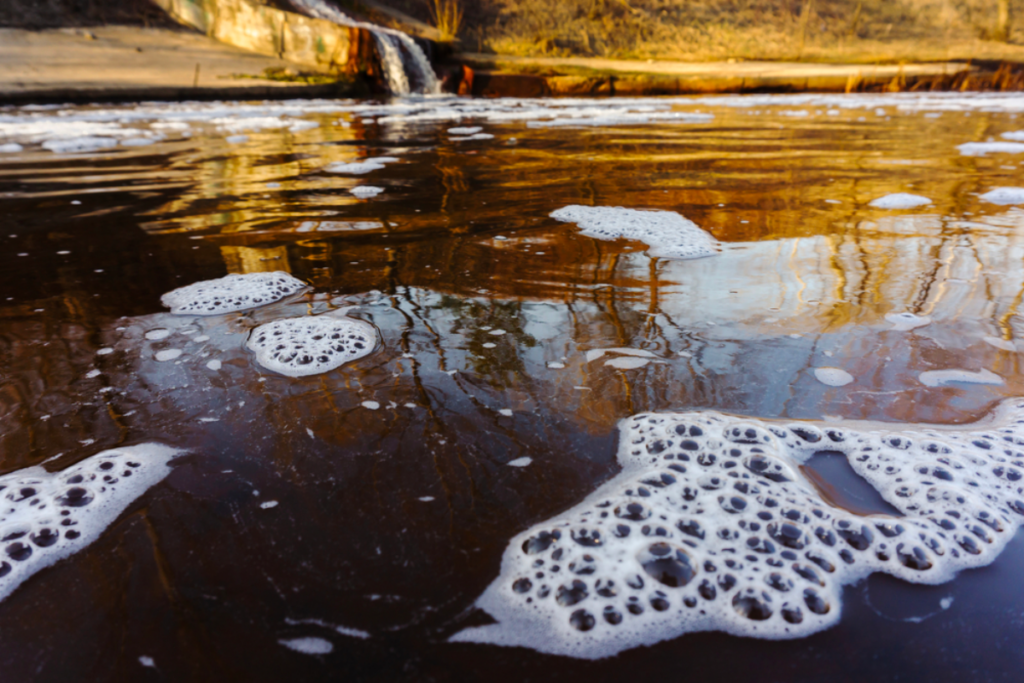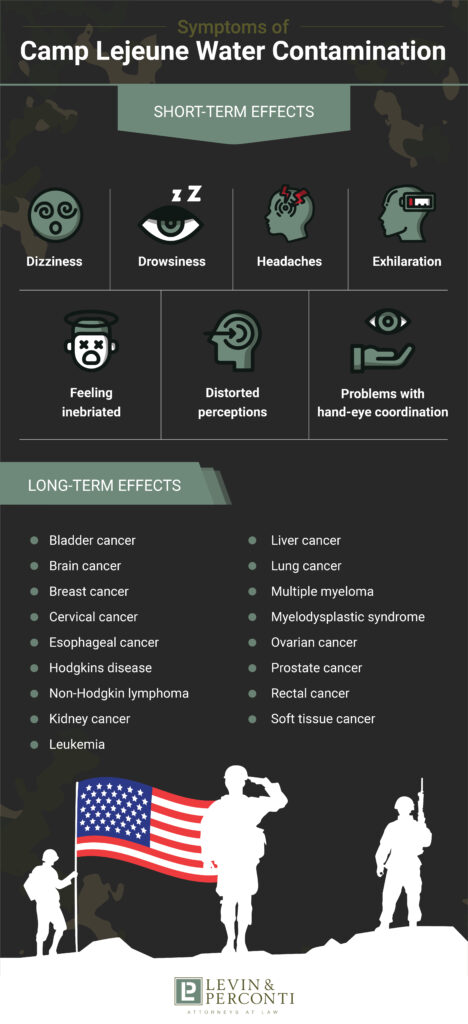Symptoms of Camp Lejeune Water Contamination
More than one million people may have been exposed to contaminated water at Camp Lejeune between 1953 and 1987. Affected people might remember experiencing short-term symptoms like dizziness and drowsiness while they lived on base. Over the long term, however, the chemicals found in Camp Lejeune water can cause a variety of serious health effects, including cancer, birth defects, and chronic diseases.
Camp Lejeune is currently home to around 150,000 people on the North Carolina coast. The population includes active-duty Marines and their families, as well as civilians and retired service members.
In 1982, the Marine Corps discovered that several water sources at Camp Lejeune were heavily contaminated with volatile organic compounds (VOCs), which can have dangerous health effects. The Centers for Disease Control and Prevention (CDC) estimates that as many as one million people were exposed to contaminated drinking water between 1953 and 1987, when the last affected well was shut down.
Quick Links
Which toxic chemicals were found at Camp Lejeune?
According to the Agency for Toxic Substances and Disease Registry (ATSDR), testing revealed dangerous VOC levels in three water distribution plants at Camp Lejeune: Hadnot Point, Holcomb Boulevard, and Tarawa Terrace. These three plants supplied water to most housing units at the base. Elevated levels of several VOCs were found, including:
- Trichloroethylene (TCE)
- Perchloroethylene (PCE)
- Vinyl chloride
- Benzene
- Trans-1,2-dichloroethylene (DCE)
In some cases, very high levels of contamination were found. At one water treatment plant, the level of TCE was more than 280 times higher than the maximum safe level. At another, the level of PCE was found to be 43 times higher than the maximum.
People could be exposed to the toxic chemicals in Camp Lejeune water directly through drinking, cooking with, or bathing in this water. They could also be exposed through a process known as vapor intrusion. VOCs are highly volatile, which means they easily evaporate and enter the air. Because VOCs were present in shallow groundwater, they could evaporate and contaminate the air around and beneath buildings. The chemicals could then enter indoor air, where people could be exposed by inhaling them.
The Agency for Toxic Substances and Disease Registry has stated that vapor intrusion is believed to have been a significant route of exposure to toxic chemicals at Camp Lejeune. The situation is still being investigated, and the full impact of this route of exposure is not yet known.

What are the symptoms of exposure to contaminated water at Camp Lejeune?
The VOCs found in the water at Camp Lejeune can cause a variety of short-term symptoms, which affected people may have noticed at the time of exposure. More concerning are the long-term symptoms of exposure to VOCs, which can cause serious health problems and even be fatal.
Short-Term Effects
Exposure to VOCs can cause short-term effects on the nervous and other body systems. Although people exposed at Camp Lejeune would not be expected to be suffering from these short-term effects now that it’s been decades since their exposure, it may be helpful for affected people to be aware of the symptoms.
Many people noticed these symptoms when they lived on base, such as after taking a shower or drinking a glass of tap water or a beverage made with tap water. If you remember suffering from the short-term effects of VOC exposure, you should be monitored for potential long-term effects, which can be very serious.
A study published in the National Academies Press (NAP) revealed the short-term effects of exposure to these chemicals, including:
- Dizziness
- Drowsiness
- Headaches
- Problems with hand-eye coordination
- Feeling inebriated
- Distorted perceptions
- Exhilaration
Long-Term Effects
Of the VOCs found at Camp Lejeune, TCE, vinyl chloride, and benzene are known human carcinogens, meaning they can cause cancer. PCE is considered to be a probable carcinogen. In addition, these VOCs can cause birth defects and other severe chronic health problems.
After an extensive investigation of the health effects of these chemicals, ATSDR concluded that there is evidence that these VOCs cause various types of cancer:
- Bladder cancer
- Brain cancer
- Breast cancer
- Cervical cancer
- Esophageal cancer
- Hodgkins disease
- Non-Hodgkin lymphoma
- Kidney cancer
- Leukemia
- Liver cancer
- Lung cancer
- Multiple myeloma
- Myelodysplastic syndrome (a cancer of certain cells in the bone marrow)
- Ovarian cancer
- Prostate cancer
- Rectal cancer
- Soft tissue cancer (may originate in muscle tissue, tendon, fat tissue, blood vessels, or other soft tissues)
In addition, these chemicals can cause other chronic health conditions:
- Aplastic anemia. A severe condition in which the bone marrow doesn’t produce enough blood cells.
- End-stage renal disease. This is also called end-stage kidney disease or kidney failure. Your kidneys no longer work properly to meet your body’s needs.
- Impaired immune system function. A condition in which the immune system is compromised and cannot protect against infection.
- Liver cirrhosis. The formation of scar tissue throughout the liver, which can lead to liver failure.
- Neurological effects. These may include delayed reaction times and problems with short-term memory, visual perception, attention, and color vision.
- Neurobehavioral performance deficits. These may include deficits in visual perception, decreased reflexes, and mood changes such as confusion, depression, and tension.
- Parkinson’s disease. A neurological disorder that leads to severe difficulty with movements of the body.
- Scleroderma. A chronic medical condition that causes a gradual hardening and tightening of the skin and other tissues.
- Severe, generalized hypersensitivity skin disorder. An autoimmune-related disease, meaning that the patient’s own immune system attacks their body’s tissues, which leads to intense inflammation and damage.
In women who were exposed while pregnant, exposure to these VOCs can lead to birth defects in the baby:
- Cardiac defects. Problems with the heart.
- Choanal atresia. A condition in which the baby is born with blocked nasal passages.
- Eye defects. A group of defects that affects vision, such as anophthalmia and optic nerve hypoplasia.
- Low birth weight. A low birth weight raises the risk of other health problems.
- Neural tube defects. This is a group of birth defects in which the brain and spinal cord structure fail to develop correctly. One common example is spina bifida, in which a part of the spinal cord is left unprotected; it can ultimately lead to issues like paralysis.
- Oral cleft defects. In this type of birth defect, the roof of the mouth doesn’t fully form, leaving an opening in it. One example is cleft lip, in which there is an opening in the child’s upper lip. Without surgery, this makes it difficult for the child to eat and speak.
Furthermore, exposure to VOCs while pregnant raises the risk of miscarriage or fetal death.

What should you do if you may have been exposed to toxic Camp Lejeune water?
Unfortunately, once you have been exposed to VOCs, nothing can be done to prevent disease. There’s no known way to remove these chemicals from the human body or reverse the damage that they’ve already done.
However, it’s still a good idea to talk with your doctor about your concerns. Even if you haven’t suffered any negative health effects yet, you should be monitored for the various potential issues these VOCs can cause. Catching these health problems early may allow for more treatment options.
If you or a family member has already experienced any of the health issues listed above, and if you lived at Camp Lejeune for at least a month between 1953 and 1987, you may be eligible for financial compensation from the federal government. The Honoring our PACT Act of 2022 was signed into law by President Biden on August 10, 2022, making it easier for those affected by this tragedy to seek justice.
If you believe you may qualify, please contact us for a free consultation. The Camp Lejeune attorneys at Levin & Perconti are committed to fighting for the rights of water contamination victims.
Testimonials
Not only were they so professional but also so caring and thoughtful. It was very difficult going over the facts in our mother's case but they were so compassionate and understanding and allowed us to be with them every step of the way. We were able to sit in on the depositions and we were really able to see how hard they worked on our behalf.
During that time, my family and I suffered the loss of my mother. Mr. Levin and Mr. Perconti were more than just our lawyers. Words can’t really express our gratitude.
They were most patient and responded timely to many questions throughout the entire process. All demonstrated professionalism and extensive knowledge of case and state laws. Their in-depth investigative work uncovered details which were unknown to us and yet sadly confirmed our suspicions. We would recommend the Levin and Perconti Law firm and especially this team.
During that time, my family and I suffered the loss of my mother. Mr. Levin and Mr. Peconti were more than just our lawyers. Words can’t really express our gratitude. My family and I will always be grateful for the compassion that they showed us. I want to thank you for what you did for my family, and for always being there for us.
Margaret’s representation, guidance, and professionalism gave us the sense that we could put our trust in Levin & Perconti and the final outcome proved that to be true.
Legally Reviewed by

Jaime Koziol Delaney
Contact Us
- Free Consultation
- (312) 332-2872
Notable Results
VERDICT
on behalf of an 85-year-old woman injured in a nursing home when her medications were mismanaged.
SETTLEMENT
for the family of a 32-year-old woman who was killed when their pick-up truck was rear-ended by a semi-truck.
Settlement
settlement to the family of a baby who suffered permanent brain damage as a result of a doctor’s negligence.
Our Office
325 N LaSalle Dr Suite 300
Chicago, IL 60654
312-332-2872